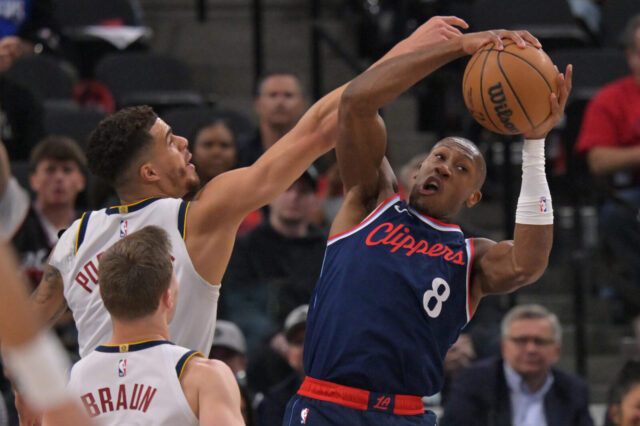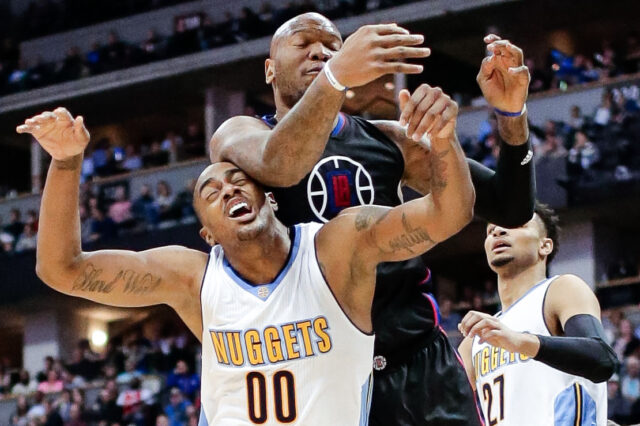Malik Beasley has had to work for everything he has earned thus far.
During his freshman season at Florida State, the talented shooting guard sustained a leg injury that dropped his stock in the 2016 NBA Draft. He fell out of the lottery, much to the benefit of the Denver Nuggets, who selected him 19th overall behind a slew of busts in the teens of that draft class.
His rookie year, Beasley played just 165 minutes across 22 games, 72 of which came in the final two games of the season after the Nuggets were eliminated from playoff contention. His second year, Beasley’s role increased minimally, appearing in 62 contests but averaging just 9.2 minutes per game. He was the victory cigar for the Nuggets, putting on a dunk show after games were already decided.
And then, it all clicked this year.
One of the ramifications of trading Wilson Chandler last summer and planning to start Will Barton during the 2018-19 season involved penciling Malik Beasley into a permanent bench role. He wasn’t going to get the quick hook he had in previous years, and head coach Michael Malone allowed him to play through mistakes that come from being young and figure out how to contribute to winning basketball. The result was an excellent season for the 22-year-old that will put a lot of positive pressure on the Nuggets front office going forward.
Simplicity allowed Beasley to grow offensively
By limiting the types of plays Beasley tried to make for himself, the sharpshooter saw his role expand as the season wore on. This may seem counterintuitive, but Beasley focusing on impacting the game as a role player helped the Nuggets throughout the season. More often than not, the Nuggets needed a functional player on the wing with the athleticism to run and the shooting to space the floor. Beasley checked both boxes in a big way.
Beasley’s penchant for fast break points proved useful in the regular season. With Nikola Jokic being maybe the best outlet passer in the NBA and the rest of the team able to bring the ball up the floor, Beasley often leaked out in transition and had some excellent dunks and layups. He averaging 1.33 points per possession as a scorer on transition plays, 87th percentile in the entire NBA and 1st among all players to log at least 200 transition possessions.
Jokic definitely aided him on these plays, but the chemistry those two shared was two-fold. Jokic had to trust that Beasley would take off at a full sprint most of the time, and Beasley had to trust Jokic to throw the pass, no matter the window.
The next step in Beasley’s evolution was becoming a knockdown spot up shooter. Beasley would often find himself in position to make wide open shots during the 2017-18 season, but afraid to make mistakes, he sometimes refused to pull the trigger. When he did, he posted average efficiency at 34%. The Nuggets knew he could do better though, as did Beasley and Malone, who continued to encourage him to let the shots fly. Beasley let them fly this year, and he didn’t disappoint, shooting over 40% from behind the arc and making 163 total threes.
Beasley was one of just seven players in their Age-22 season or younger to average two or more made three-pointers in a game in 2018-19. Sorted by efficiency, only Landry Shamet tops Denver’s young shooting guard. The rest of the players on the list—Jamal Murray, Luka Doncic, Donovan Mitchell, Devin Booker, and D’Angelo Russell—are considered by many to be star prospects. Beasley’s three-point looks were certainly less challenging than those of the star players, but it’s encouraging to see him hit a high percentage in his first real rotation minutes.
The variety of shots Beasley attempted was not high this year, but that played to his strengths. Over half of his shots attempted were threes, and that boosted his efficiency, having averaged a sterling 1.207 points per attempted three. The next highest shot location frequency occurred right at the rim where Beasley shot an even more impressive 73.2%, highest among all guards to attempt as many shots at the rim. The primary reason, over 82% of Beasley’s field goals at the rim were assisted.
Defensive struggles mostly hidden yet ever present
The biggest reasons Beasley struggled to see the floor for his first two years were defensive. Not much changed in Beasley’s third season outside of Denver’s desperate need for bench spacing and offense, and in more time on the floor, Beasley’s biggest defensive struggles were highlighted.
During the regular season and postseason, Beasley struggled to keep track of his man and the ball at the same time. On 162 possessions defending spot up scorers, Beasley allowed 1.15 points per possession, translating to just the 15th percentile around the NBA and equivalent to a Kawhi Leonard or Khris Middleton spot up jumper. Considering Beasley primarily defended bench wings, this is was poor form. When tasked with defending players that were tougher to guard in the playoffs, he didn’t stick tightly to them either.
That’s CJ McCollum Beasley just lost off ball. Not a great look.
In addition, Beasley was poor defending opposing players coming off screens, allowing an absurd 1.31 points per possession during the regular season. That was the worst mark among players to defend as many off-ball screen possessions as Beasley, and it’s easy to see why he struggled.
Beasley tends to struggle in his off-ball recognition, falling a step behind the shooter regardless of which way they decide to go. When he does give chase, he often gets caught up by the screener, something that can’t happen in today’s NBA. The shooters are too quick off the catch, especially an elite sniper like Klay Thompson, who attempted 500 field goals immediately following an off-ball screen this year and was still 72nd percentile after a slow start to the season.
However, the Nuggets were able to mitigate Beasley’s struggles in their best lineups. One of Denver’s best lineup combinations featured the trio of Beasley, Nikola Jokic, and Paul Millsap. In 455 minutes together, the trio posted a +16.2 Net Rating, the seventh best trio in the NBA behind four combinations from the Golden State Warriors, a unit from the Toronto Raptors, and the primary bench unit for the San Antonio Spurs. Pretty good company, aided by excellent two-way play from Denver’s front court and the added spacing and transition play of Beasley.
So, Beasley CAN be hidden defensively due to his offensive talent, but it would be easier for everyone involved if he improved on the less glamorous end.
Should Beasley assume a larger role in Denver?
Beasley clearly has the makings of an elite 3-and-D player down the road. The three-pointer is nearly there already, and I expect Beasley to continue improving defensively as he gains more experience and realizes how important that end of the floor is to a player of his size.
The question is: has Beasley earned the opportunity to be more than just a 3-and-D guard?
Though his possessions were limited in the regular season, Beasley was a solid pick and roll scorer. Averaging 0.92 points per possession, he was in the 72nd percentile around the NBA, slightly higher than Jamal Murray and way higher than (an injured) Will Barton. He also operated the Dribble Hand Off game reasonably well with Nikola Jokic and Mason Plumlee, and while he finished in just the 45th percentile for efficiency, the tools were clearly there to improve beyond that.
When afforded a larger role in 18 starts this season, Beasley was up to the task, averaging 15.6 points per game on an absurd 70% True Shooting. This included a 35 point outing against the Houston Rockets, filling in for Gary Harris with an efficient 12 of 17 shooting from the field.
With a compilation of sweet jumpers, hard drives to the basket, and even a nice pass to Jokic in the pick and roll, Beasley showed exactly what his future could hold if given the right opportunity. Other teams know this too. With Beasley set to be a restricted free agent in a weak 2020 free agent class, teams around the NBA will be scoping out potential diamonds in the rough. Beasley is well thought of around the league, and some team is almost assured to offer him starter level money to take a chance on his potential going forward.
This means the Nuggets have a big choice to make. With over $33 million tied up between incumbent wing starters Gary Harris and Will Barton, and with Jamal Murray set to incur a major raise of his own, there just isn’t enough money to keep every capable guard/wing player around. Monte Morris possesses an affordable contract, but Paul Millsap does not. Might the Nuggets have to lose Millsap in order to keep Beasley around. Losing the starting power forward in order to pay a bench shooting guard doesn’t seem logical at all.
So, the Nuggets may have to decide whether Beasley can and should be in the long term plans. Malone, Tim Connelly, and the rest of the Nuggets staff would surely love to have him around, but finances complicate the matter, and his duplicative position on the wing puts the Nuggets at a major disadvantage when trying to defend the NBA’s best big wings and small forwards.
It doesn’t necessarily have to be Beasley that departs in this scenario, but he’s likely the player that potential suitors would most want between him, Harris, and Barton. It would be easiest to trade him for high value, while Harris and Barton wouldn’t generate nearly the same return due to contracts and nagging injury issues.
However, I believe Beasley should assume a larger role in Denver. In fact, I believe he should start at small forward next season, barring no significant changes to the roster. Michael Porter Jr. is on the way, but I expect Denver to start him off slowly, easing him into the pressures of the NBA to ensure he stays healthy. Barton struggled last year, and I doubt the Nuggets would like to see him defend small forwards consistently this coming year. Beasley has potential to operate there though, much in the same way that Eric Gordon plays next to the primary actions on the Houston Rockets. Gordon thickened up his body frame to defend small forwards more capably, and I believe Beasley should do the same. That’s the best avenue for him to start with the Nuggets seeing as Harris is currently entrenched in the starting job. While he may find more individual success trying to be a scoring shooting guard on a rebuilding team, he could be a great fourth or fifth option in Denver’s starting unit with the potential to develop into something more. It would be a move to continue highlighting the continuity of Denver’s roster while exploring new possibilities to improve on the margins.
Whatever the Nuggets decide to do though, Beasley will have earned it. He fought tooth and nail to get where he is today, overcoming major injuries, spotty playing time, and a small role to become an important piece for this Nuggets team. At just 22 years old, Beasley could still be almost whatever he wants to be. The most mature decision though would be to assume the role Denver needs him to fill. He excelled doing so last year. Now, it could be time for him to excel in a larger role.


